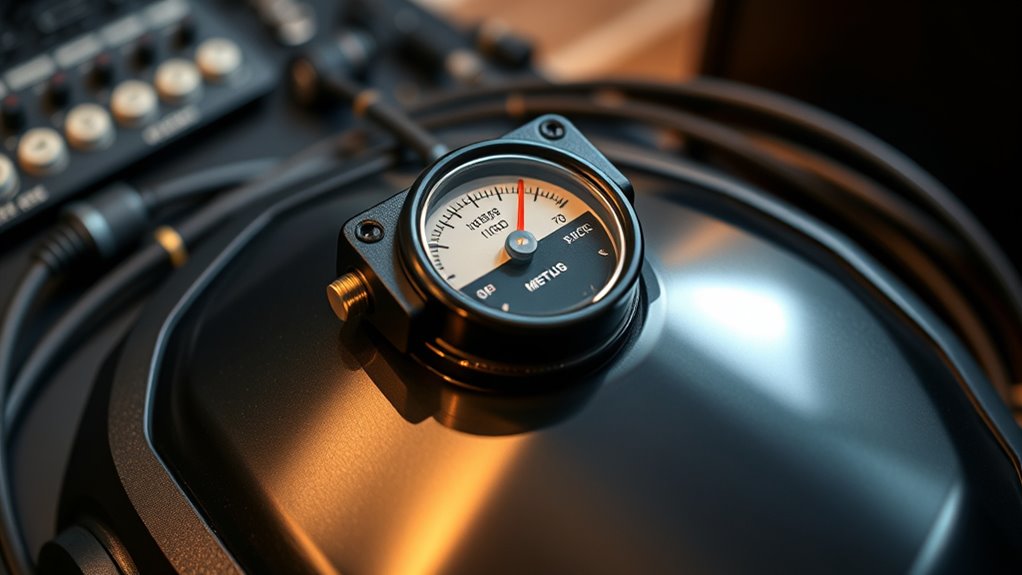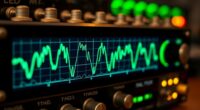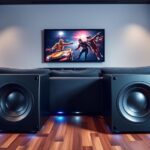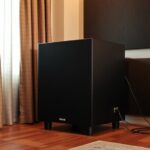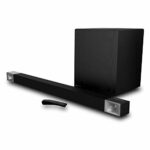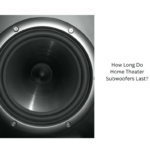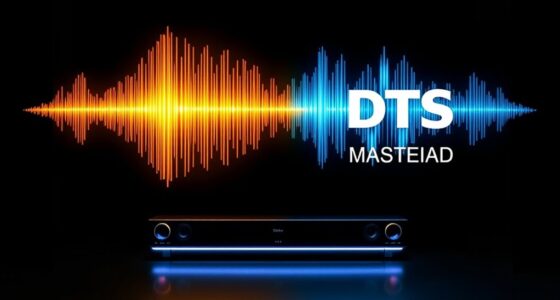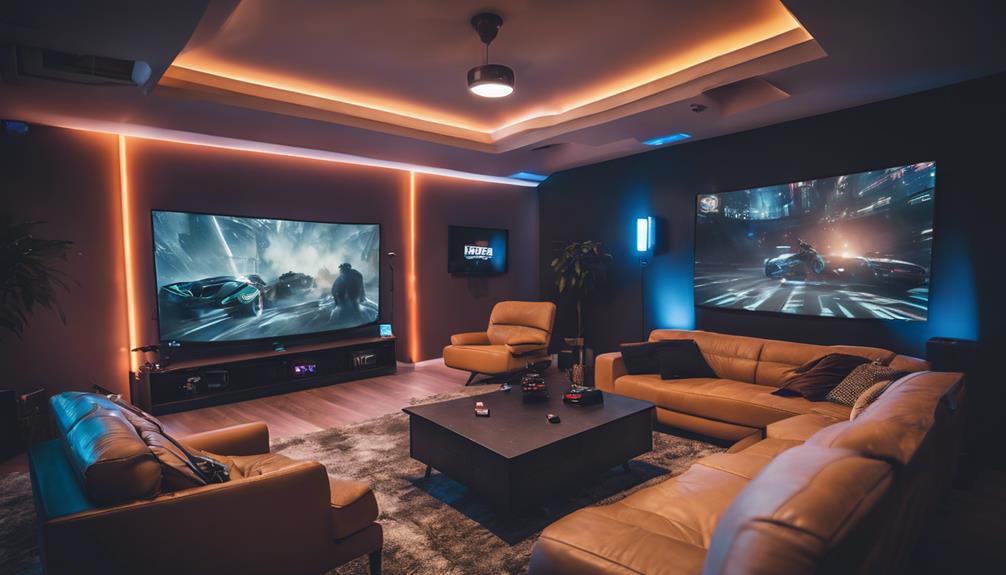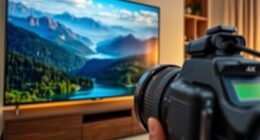To calibrate your subwoofer with an SPL meter, place the mic at ear level and set your system to a moderate volume. Play a test tone or bass-heavy track and adjust the subwoofer’s volume until the SPL meter reads 75-85 dB, depending on room size and preference. Fine-tune the crossover and placement for even bass response across the listening area. Keep these steps in mind to achieve balanced, natural bass—if you continue exploring, you’ll discover more pro tips.
Key Takeaways
- Position the SPL meter at ear level at your listening spot to accurately measure bass levels during calibration.
- Adjust the subwoofer’s volume until the SPL meter reads between 75-85 dB for balanced, natural bass.
- Set the crossover frequency between 80-120 Hz to prevent overlap and ensure seamless integration with main speakers.
- Move the SPL meter around the room to identify uneven bass distribution and optimize subwoofer placement accordingly.
- Record and recheck settings periodically to maintain optimal bass performance as room acoustics change.
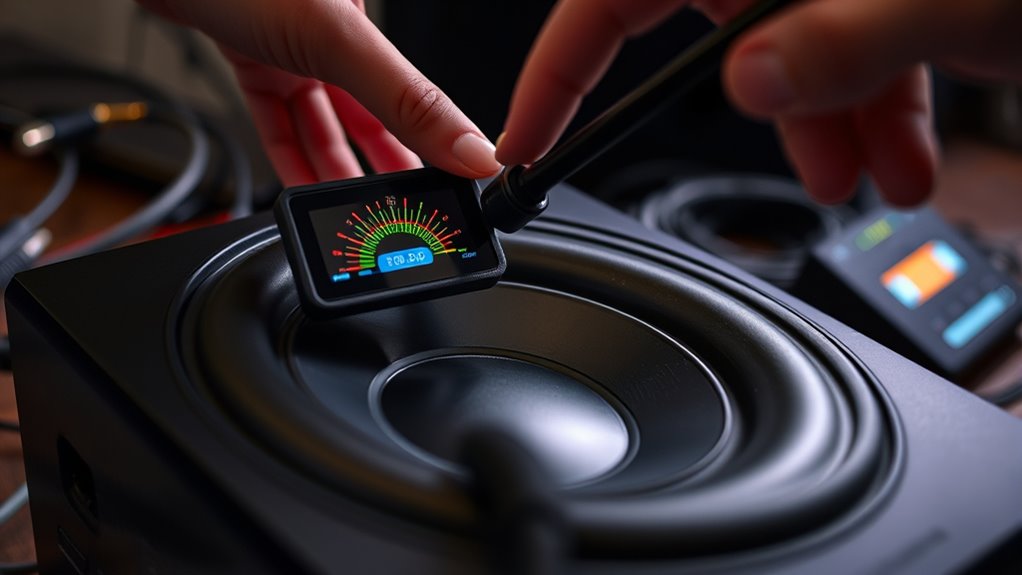
Calibrating your subwoofer is vital to achieving balanced and immersive sound in your space. When done correctly, it guarantees that your bass isn’t overpowering or underwhelming, creating a seamless listening experience. The key tool for this process is an SPL (Sound Pressure Level) meter, which measures the loudness of your subwoofer accurately. Using an SPL meter may seem intimidating at first, but with a few straightforward steps, you’ll be able to fine-tune your system with confidence. Start by placing the SPL meter at your typical listening position, at ear level. Turn on your audio system and set the volume to a moderate level. Play a test tone or a bass-rich track, and hold the SPL meter’s microphone near your ear. Adjust your subwoofer’s volume control until the SPL meter reads around 75 to 85 decibels, depending on your preference and room size. This range offers a good balance of bass without overwhelming the other frequencies. Once you’ve set the initial volume, it’s vital to establish a reference point for your calibration. Many recommend setting your subwoofer’s crossover frequency between 80 and 120 Hz, depending on your main speakers’ capabilities. This prevents the sub from overlapping excessively with your other speakers. Now, use your SPL meter to fine-tune the subwoofer’s level. Play a variety of content—music, movies, or test tones—and listen carefully. Adjust the subwoofer’s gain or level control until the bass feels natural, neither too boomy nor too weak. Remember, your goal is a cohesive soundstage where the bass supports the overall mix without drawing undue attention to itself. It’s also essential to check your calibration across the listening area. If possible, move the SPL meter to different spots in your room and verify that the levels remain consistent. Uneven bass distribution might require repositioning your subwoofer or adding acoustic treatments to improve sound quality. Additionally, considering the influence of room acoustics can help optimize your setup for even better sound quality. Understanding speaker placement techniques can significantly impact your calibration results. Incorporating knowledge of sound absorption can help reduce unwanted reverberations that interfere with bass clarity. Moreover, paying attention to room size can guide you in selecting the right subwoofer and settings for optimal performance. A thorough understanding of filtration efficiency can assist in choosing the right subwoofer and accessories for your needs. Once satisfied, make a note of your settings for future reference. Keep in mind that room acoustics can change over time, so periodic re-calibration is advisable. Proper subwoofer calibration with an SPL meter results in a more accurate and enjoyable listening experience, whether you’re enjoying movies or music. It’s a simple yet effective way to guarantee your sound system performs at its best, giving you deep, rich bass that complements your space perfectly.
Frequently Asked Questions
Can I Calibrate My Subwoofer Without Professional Equipment?
You can calibrate your subwoofer without professional equipment, but it’s a bit tricky. Start by setting your volume levels to a moderate point. Use a smartphone app that functions as a sound level meter to measure bass output. Play a test tone or your favorite bass-heavy track, then adjust the subwoofer’s volume until the bass sounds balanced and deep across your listening space. It might take some trial and error, but it’s doable.
How Often Should I Recalibrate My Subwoofer for Optimal Sound?
You should recalibrate your subwoofer whenever you notice changes in sound quality, such as uneven bass or distortion. Regular recalibration, about every six months or after significant setup changes, helps maintain ideal sound. Environmental factors like room acoustics or new furniture can also affect performance, so keep an ear out for inconsistencies. Consistent calibration ensures your bass remains tight, balanced, and enjoyable, enhancing your overall listening experience.
Does Room Acoustics Affect SPL Meter Readings Significantly?
Room acoustics definitely impact SPL meter readings. Your room’s size, shape, and materials can cause sound reflections, absorptions, and standing waves, which skew measurements. When you use an SPL meter, these factors can make your readings higher or lower than actual subwoofer output. To get accurate results, you should calibrate in the same room where you’ll listen and consider treating reflections with acoustic panels or bass traps.
What’s the Ideal SPL Level for Home Theater Subwoofers?
You should aim for your home theater subwoofer to hit around 80 to 85 dB for ideal sound. This level provides powerful bass without distortion or overwhelming the other audio. Use an SPL meter to measure consistently at the listening position, making adjustments as needed. Keep in mind, room acoustics can influence readings, so fine-tune your setup for the best balance between loudness and clarity.
How Do I Troubleshoot Uneven Bass After Calibration?
If you notice uneven bass after calibration, start by checking your subwoofer’s placement. Moving it closer to walls or corners can boost bass response. Also, verify your calibration process—ensure your SPL meter is at ear level and you’re using the correct measurement. Adjust the phase or crossover settings slightly, and listen again. Sometimes, small tweaks make a big difference in achieving balanced, even bass across your listening area.
Conclusion
Now that you know how to calibrate your subwoofer using an SPL meter, you’re well on your way to perfect bass. Did you know that properly calibrated subwoofers can improve sound clarity by up to 30%? By following these steps, you guarantee your system delivers balanced, punchy lows every time. Remember, a little effort goes a long way in mastering your home theater experience. Happy listening!
Hello, I’m Art, and I’m excited to be a part of the 1Home Theatre Projector team. As a writer, I’m here to contribute my knowledge and insights to help you achieve the ultimate home cinema experience. I understand that making decisions in the world of home entertainment can be complex, and I’m here to simplify the process for you.
